Glass Ceiling Research Report
VerifiedAdded on 2019/10/01
|13
|4701
|496
Report
AI Summary
This report investigates the glass ceiling phenomenon, focusing on its nature, impact on the workforce and organizations, and potential solutions. The report begins by introducing the concept of the glass ceiling as an invisible barrier hindering women's career advancement. It then delves into the background, exploring the increasing participation of women in the workforce while highlighting their underrepresentation in senior management roles. The report examines various barriers contributing to the glass ceiling, including pay disparity, lack of experience due to career breaks, part-time employment, and undervaluing of women's roles. A literature review section explores existing theories and research on the glass ceiling, examining its impact on employee satisfaction, performance, and organizational productivity. The report aims to identify factors causing the glass ceiling, its effects on the workforce and organization, and recommends strategies for mitigating its negative consequences. The report concludes by suggesting solutions such as implementing merit-based practices, strengthening equality policies, proactive recruitment, addressing corporate climate barriers, and developing mentoring programs to promote women's advancement.

GLASS CEILING
Paraphrase This Document
Need a fresh take? Get an instant paraphrase of this document with our AI Paraphraser
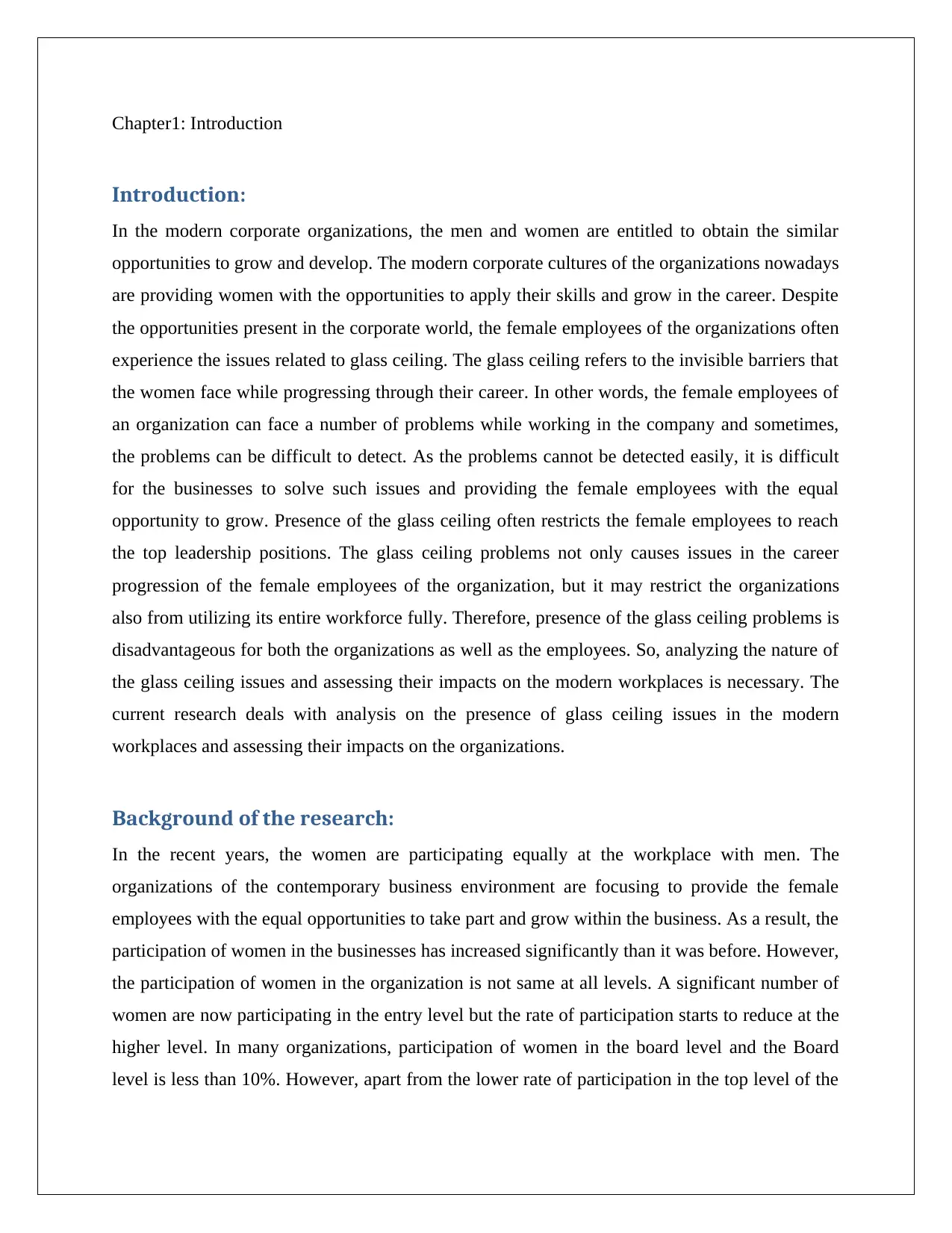
Chapter1: Introduction
Introduction:
In the modern corporate organizations, the men and women are entitled to obtain the similar
opportunities to grow and develop. The modern corporate cultures of the organizations nowadays
are providing women with the opportunities to apply their skills and grow in the career. Despite
the opportunities present in the corporate world, the female employees of the organizations often
experience the issues related to glass ceiling. The glass ceiling refers to the invisible barriers that
the women face while progressing through their career. In other words, the female employees of
an organization can face a number of problems while working in the company and sometimes,
the problems can be difficult to detect. As the problems cannot be detected easily, it is difficult
for the businesses to solve such issues and providing the female employees with the equal
opportunity to grow. Presence of the glass ceiling often restricts the female employees to reach
the top leadership positions. The glass ceiling problems not only causes issues in the career
progression of the female employees of the organization, but it may restrict the organizations
also from utilizing its entire workforce fully. Therefore, presence of the glass ceiling problems is
disadvantageous for both the organizations as well as the employees. So, analyzing the nature of
the glass ceiling issues and assessing their impacts on the modern workplaces is necessary. The
current research deals with analysis on the presence of glass ceiling issues in the modern
workplaces and assessing their impacts on the organizations.
Background of the research:
In the recent years, the women are participating equally at the workplace with men. The
organizations of the contemporary business environment are focusing to provide the female
employees with the equal opportunities to take part and grow within the business. As a result, the
participation of women in the businesses has increased significantly than it was before. However,
the participation of women in the organization is not same at all levels. A significant number of
women are now participating in the entry level but the rate of participation starts to reduce at the
higher level. In many organizations, participation of women in the board level and the Board
level is less than 10%. However, apart from the lower rate of participation in the top level of the
Introduction:
In the modern corporate organizations, the men and women are entitled to obtain the similar
opportunities to grow and develop. The modern corporate cultures of the organizations nowadays
are providing women with the opportunities to apply their skills and grow in the career. Despite
the opportunities present in the corporate world, the female employees of the organizations often
experience the issues related to glass ceiling. The glass ceiling refers to the invisible barriers that
the women face while progressing through their career. In other words, the female employees of
an organization can face a number of problems while working in the company and sometimes,
the problems can be difficult to detect. As the problems cannot be detected easily, it is difficult
for the businesses to solve such issues and providing the female employees with the equal
opportunity to grow. Presence of the glass ceiling often restricts the female employees to reach
the top leadership positions. The glass ceiling problems not only causes issues in the career
progression of the female employees of the organization, but it may restrict the organizations
also from utilizing its entire workforce fully. Therefore, presence of the glass ceiling problems is
disadvantageous for both the organizations as well as the employees. So, analyzing the nature of
the glass ceiling issues and assessing their impacts on the modern workplaces is necessary. The
current research deals with analysis on the presence of glass ceiling issues in the modern
workplaces and assessing their impacts on the organizations.
Background of the research:
In the recent years, the women are participating equally at the workplace with men. The
organizations of the contemporary business environment are focusing to provide the female
employees with the equal opportunities to take part and grow within the business. As a result, the
participation of women in the businesses has increased significantly than it was before. However,
the participation of women in the organization is not same at all levels. A significant number of
women are now participating in the entry level but the rate of participation starts to reduce at the
higher level. In many organizations, participation of women in the board level and the Board
level is less than 10%. However, apart from the lower rate of participation in the top level of the
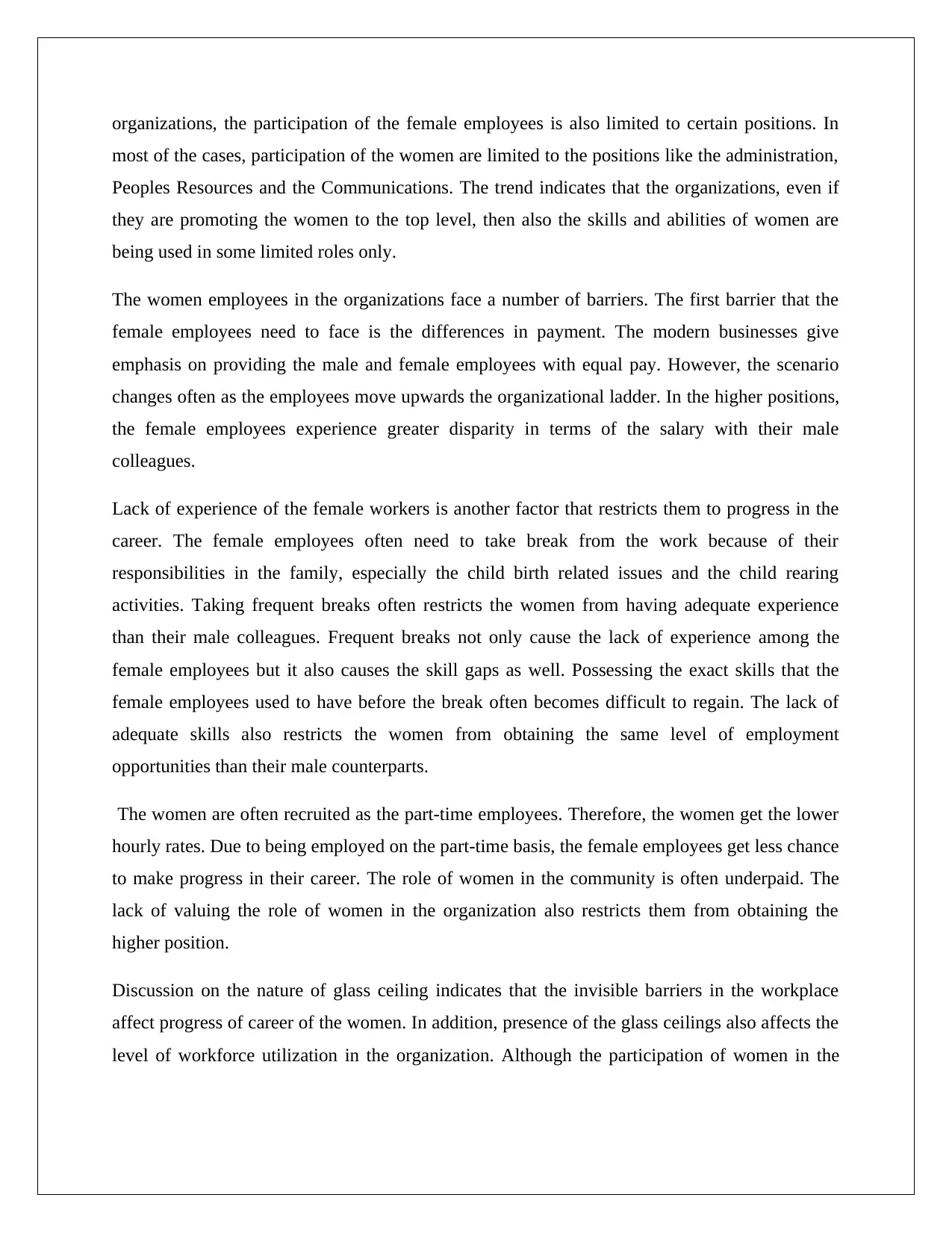
organizations, the participation of the female employees is also limited to certain positions. In
most of the cases, participation of the women are limited to the positions like the administration,
Peoples Resources and the Communications. The trend indicates that the organizations, even if
they are promoting the women to the top level, then also the skills and abilities of women are
being used in some limited roles only.
The women employees in the organizations face a number of barriers. The first barrier that the
female employees need to face is the differences in payment. The modern businesses give
emphasis on providing the male and female employees with equal pay. However, the scenario
changes often as the employees move upwards the organizational ladder. In the higher positions,
the female employees experience greater disparity in terms of the salary with their male
colleagues.
Lack of experience of the female workers is another factor that restricts them to progress in the
career. The female employees often need to take break from the work because of their
responsibilities in the family, especially the child birth related issues and the child rearing
activities. Taking frequent breaks often restricts the women from having adequate experience
than their male colleagues. Frequent breaks not only cause the lack of experience among the
female employees but it also causes the skill gaps as well. Possessing the exact skills that the
female employees used to have before the break often becomes difficult to regain. The lack of
adequate skills also restricts the women from obtaining the same level of employment
opportunities than their male counterparts.
The women are often recruited as the part-time employees. Therefore, the women get the lower
hourly rates. Due to being employed on the part-time basis, the female employees get less chance
to make progress in their career. The role of women in the community is often underpaid. The
lack of valuing the role of women in the organization also restricts them from obtaining the
higher position.
Discussion on the nature of glass ceiling indicates that the invisible barriers in the workplace
affect progress of career of the women. In addition, presence of the glass ceilings also affects the
level of workforce utilization in the organization. Although the participation of women in the
most of the cases, participation of the women are limited to the positions like the administration,
Peoples Resources and the Communications. The trend indicates that the organizations, even if
they are promoting the women to the top level, then also the skills and abilities of women are
being used in some limited roles only.
The women employees in the organizations face a number of barriers. The first barrier that the
female employees need to face is the differences in payment. The modern businesses give
emphasis on providing the male and female employees with equal pay. However, the scenario
changes often as the employees move upwards the organizational ladder. In the higher positions,
the female employees experience greater disparity in terms of the salary with their male
colleagues.
Lack of experience of the female workers is another factor that restricts them to progress in the
career. The female employees often need to take break from the work because of their
responsibilities in the family, especially the child birth related issues and the child rearing
activities. Taking frequent breaks often restricts the women from having adequate experience
than their male colleagues. Frequent breaks not only cause the lack of experience among the
female employees but it also causes the skill gaps as well. Possessing the exact skills that the
female employees used to have before the break often becomes difficult to regain. The lack of
adequate skills also restricts the women from obtaining the same level of employment
opportunities than their male counterparts.
The women are often recruited as the part-time employees. Therefore, the women get the lower
hourly rates. Due to being employed on the part-time basis, the female employees get less chance
to make progress in their career. The role of women in the community is often underpaid. The
lack of valuing the role of women in the organization also restricts them from obtaining the
higher position.
Discussion on the nature of glass ceiling indicates that the invisible barriers in the workplace
affect progress of career of the women. In addition, presence of the glass ceilings also affects the
level of workforce utilization in the organization. Although the participation of women in the
⊘ This is a preview!⊘
Do you want full access?
Subscribe today to unlock all pages.

Trusted by 1+ million students worldwide
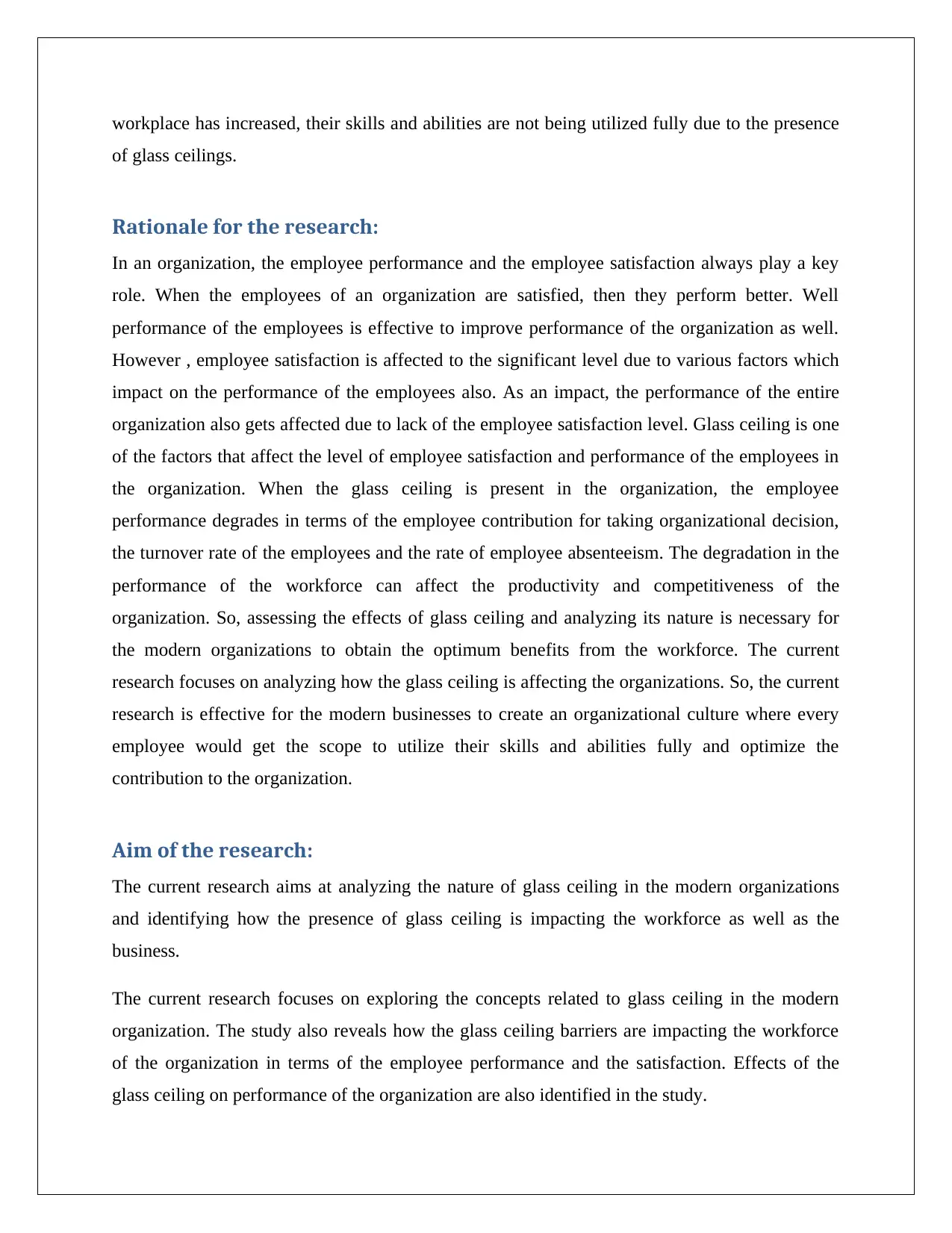
workplace has increased, their skills and abilities are not being utilized fully due to the presence
of glass ceilings.
Rationale for the research:
In an organization, the employee performance and the employee satisfaction always play a key
role. When the employees of an organization are satisfied, then they perform better. Well
performance of the employees is effective to improve performance of the organization as well.
However , employee satisfaction is affected to the significant level due to various factors which
impact on the performance of the employees also. As an impact, the performance of the entire
organization also gets affected due to lack of the employee satisfaction level. Glass ceiling is one
of the factors that affect the level of employee satisfaction and performance of the employees in
the organization. When the glass ceiling is present in the organization, the employee
performance degrades in terms of the employee contribution for taking organizational decision,
the turnover rate of the employees and the rate of employee absenteeism. The degradation in the
performance of the workforce can affect the productivity and competitiveness of the
organization. So, assessing the effects of glass ceiling and analyzing its nature is necessary for
the modern organizations to obtain the optimum benefits from the workforce. The current
research focuses on analyzing how the glass ceiling is affecting the organizations. So, the current
research is effective for the modern businesses to create an organizational culture where every
employee would get the scope to utilize their skills and abilities fully and optimize the
contribution to the organization.
Aim of the research:
The current research aims at analyzing the nature of glass ceiling in the modern organizations
and identifying how the presence of glass ceiling is impacting the workforce as well as the
business.
The current research focuses on exploring the concepts related to glass ceiling in the modern
organization. The study also reveals how the glass ceiling barriers are impacting the workforce
of the organization in terms of the employee performance and the satisfaction. Effects of the
glass ceiling on performance of the organization are also identified in the study.
of glass ceilings.
Rationale for the research:
In an organization, the employee performance and the employee satisfaction always play a key
role. When the employees of an organization are satisfied, then they perform better. Well
performance of the employees is effective to improve performance of the organization as well.
However , employee satisfaction is affected to the significant level due to various factors which
impact on the performance of the employees also. As an impact, the performance of the entire
organization also gets affected due to lack of the employee satisfaction level. Glass ceiling is one
of the factors that affect the level of employee satisfaction and performance of the employees in
the organization. When the glass ceiling is present in the organization, the employee
performance degrades in terms of the employee contribution for taking organizational decision,
the turnover rate of the employees and the rate of employee absenteeism. The degradation in the
performance of the workforce can affect the productivity and competitiveness of the
organization. So, assessing the effects of glass ceiling and analyzing its nature is necessary for
the modern organizations to obtain the optimum benefits from the workforce. The current
research focuses on analyzing how the glass ceiling is affecting the organizations. So, the current
research is effective for the modern businesses to create an organizational culture where every
employee would get the scope to utilize their skills and abilities fully and optimize the
contribution to the organization.
Aim of the research:
The current research aims at analyzing the nature of glass ceiling in the modern organizations
and identifying how the presence of glass ceiling is impacting the workforce as well as the
business.
The current research focuses on exploring the concepts related to glass ceiling in the modern
organization. The study also reveals how the glass ceiling barriers are impacting the workforce
of the organization in terms of the employee performance and the satisfaction. Effects of the
glass ceiling on performance of the organization are also identified in the study.
Paraphrase This Document
Need a fresh take? Get an instant paraphrase of this document with our AI Paraphraser
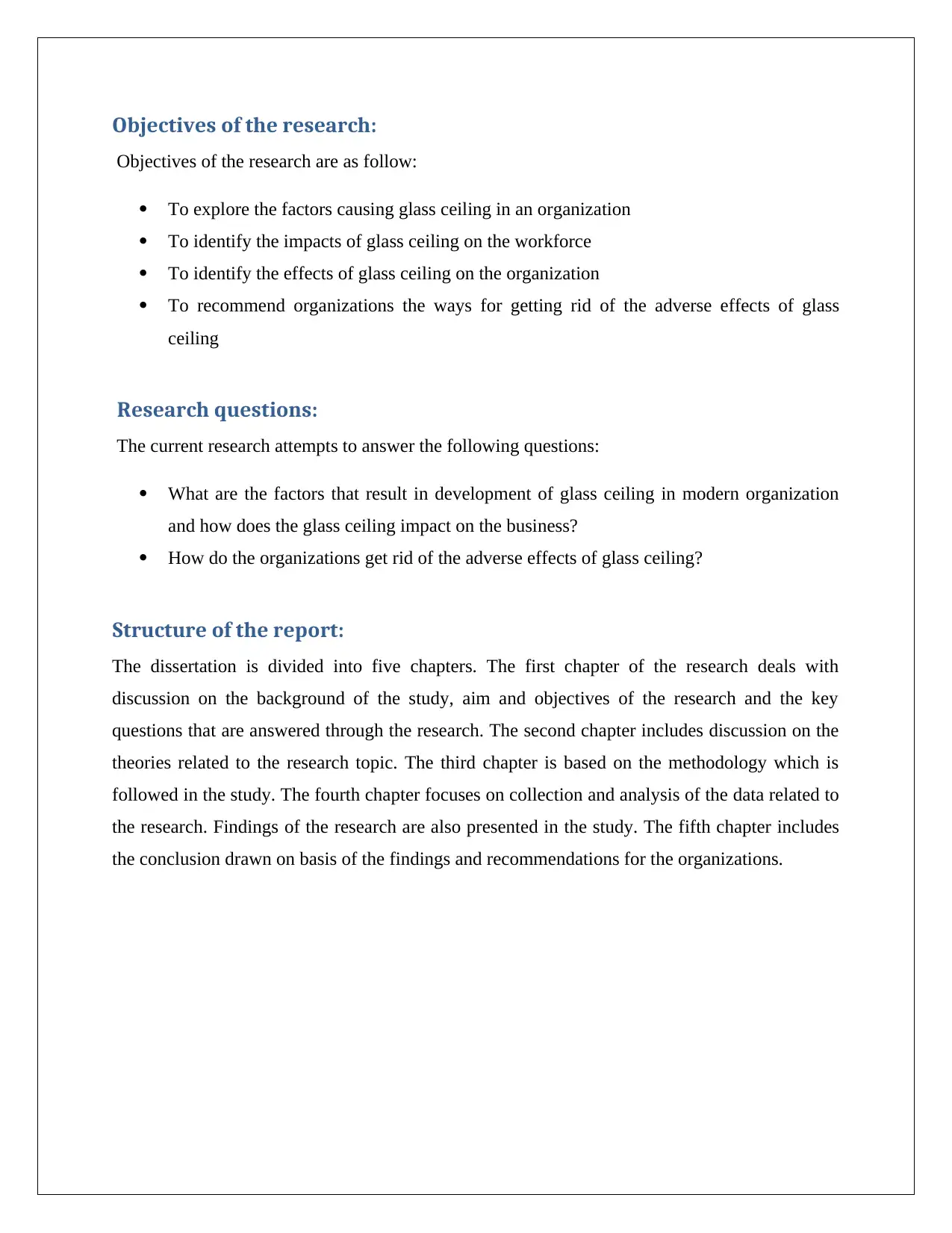
Objectives of the research:
Objectives of the research are as follow:
To explore the factors causing glass ceiling in an organization
To identify the impacts of glass ceiling on the workforce
To identify the effects of glass ceiling on the organization
To recommend organizations the ways for getting rid of the adverse effects of glass
ceiling
Research questions:
The current research attempts to answer the following questions:
What are the factors that result in development of glass ceiling in modern organization
and how does the glass ceiling impact on the business?
How do the organizations get rid of the adverse effects of glass ceiling?
Structure of the report:
The dissertation is divided into five chapters. The first chapter of the research deals with
discussion on the background of the study, aim and objectives of the research and the key
questions that are answered through the research. The second chapter includes discussion on the
theories related to the research topic. The third chapter is based on the methodology which is
followed in the study. The fourth chapter focuses on collection and analysis of the data related to
the research. Findings of the research are also presented in the study. The fifth chapter includes
the conclusion drawn on basis of the findings and recommendations for the organizations.
Objectives of the research are as follow:
To explore the factors causing glass ceiling in an organization
To identify the impacts of glass ceiling on the workforce
To identify the effects of glass ceiling on the organization
To recommend organizations the ways for getting rid of the adverse effects of glass
ceiling
Research questions:
The current research attempts to answer the following questions:
What are the factors that result in development of glass ceiling in modern organization
and how does the glass ceiling impact on the business?
How do the organizations get rid of the adverse effects of glass ceiling?
Structure of the report:
The dissertation is divided into five chapters. The first chapter of the research deals with
discussion on the background of the study, aim and objectives of the research and the key
questions that are answered through the research. The second chapter includes discussion on the
theories related to the research topic. The third chapter is based on the methodology which is
followed in the study. The fourth chapter focuses on collection and analysis of the data related to
the research. Findings of the research are also presented in the study. The fifth chapter includes
the conclusion drawn on basis of the findings and recommendations for the organizations.
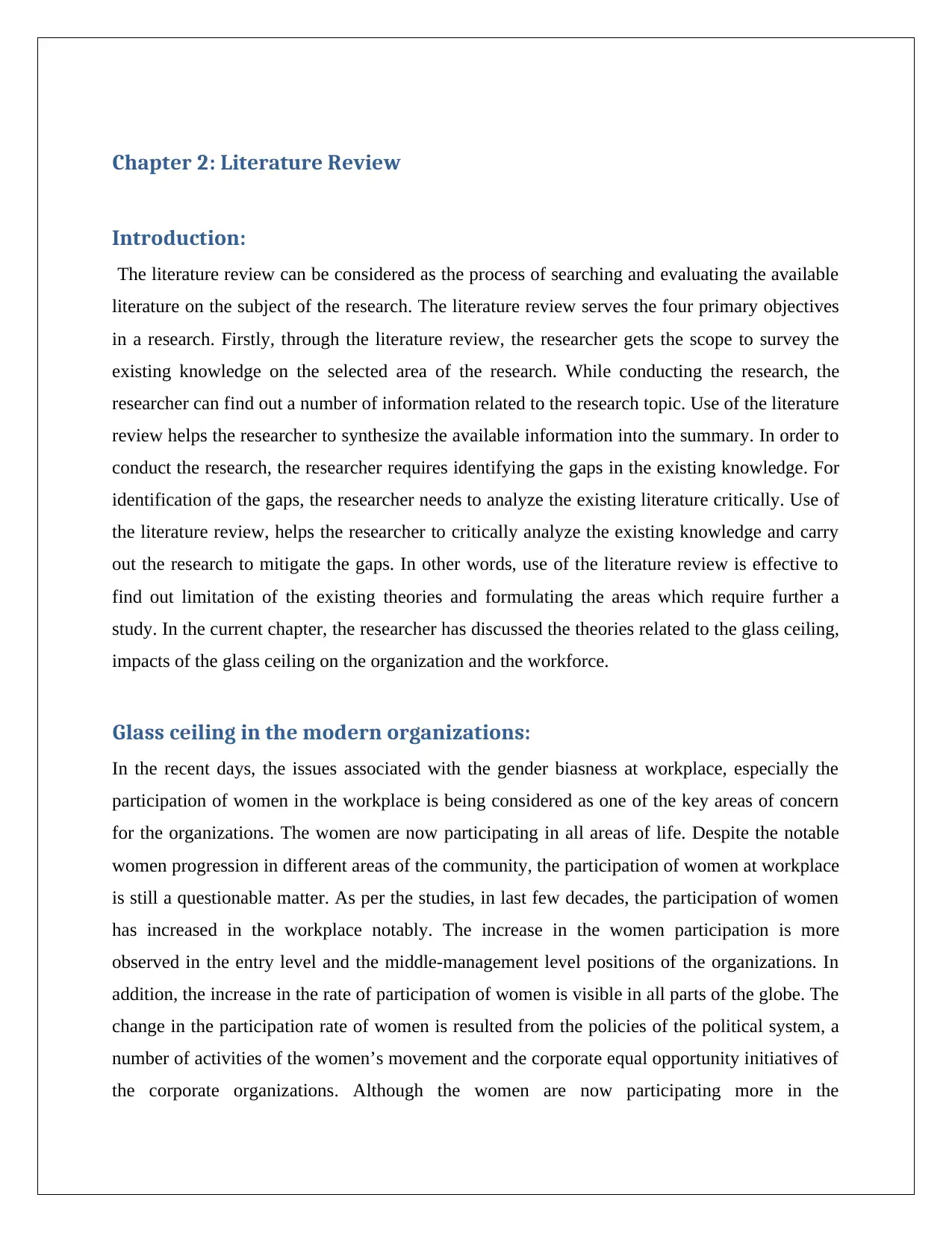
Chapter 2: Literature Review
Introduction:
The literature review can be considered as the process of searching and evaluating the available
literature on the subject of the research. The literature review serves the four primary objectives
in a research. Firstly, through the literature review, the researcher gets the scope to survey the
existing knowledge on the selected area of the research. While conducting the research, the
researcher can find out a number of information related to the research topic. Use of the literature
review helps the researcher to synthesize the available information into the summary. In order to
conduct the research, the researcher requires identifying the gaps in the existing knowledge. For
identification of the gaps, the researcher needs to analyze the existing literature critically. Use of
the literature review, helps the researcher to critically analyze the existing knowledge and carry
out the research to mitigate the gaps. In other words, use of the literature review is effective to
find out limitation of the existing theories and formulating the areas which require further a
study. In the current chapter, the researcher has discussed the theories related to the glass ceiling,
impacts of the glass ceiling on the organization and the workforce.
Glass ceiling in the modern organizations:
In the recent days, the issues associated with the gender biasness at workplace, especially the
participation of women in the workplace is being considered as one of the key areas of concern
for the organizations. The women are now participating in all areas of life. Despite the notable
women progression in different areas of the community, the participation of women at workplace
is still a questionable matter. As per the studies, in last few decades, the participation of women
has increased in the workplace notably. The increase in the women participation is more
observed in the entry level and the middle-management level positions of the organizations. In
addition, the increase in the rate of participation of women is visible in all parts of the globe. The
change in the participation rate of women is resulted from the policies of the political system, a
number of activities of the women’s movement and the corporate equal opportunity initiatives of
the corporate organizations. Although the women are now participating more in the
Introduction:
The literature review can be considered as the process of searching and evaluating the available
literature on the subject of the research. The literature review serves the four primary objectives
in a research. Firstly, through the literature review, the researcher gets the scope to survey the
existing knowledge on the selected area of the research. While conducting the research, the
researcher can find out a number of information related to the research topic. Use of the literature
review helps the researcher to synthesize the available information into the summary. In order to
conduct the research, the researcher requires identifying the gaps in the existing knowledge. For
identification of the gaps, the researcher needs to analyze the existing literature critically. Use of
the literature review, helps the researcher to critically analyze the existing knowledge and carry
out the research to mitigate the gaps. In other words, use of the literature review is effective to
find out limitation of the existing theories and formulating the areas which require further a
study. In the current chapter, the researcher has discussed the theories related to the glass ceiling,
impacts of the glass ceiling on the organization and the workforce.
Glass ceiling in the modern organizations:
In the recent days, the issues associated with the gender biasness at workplace, especially the
participation of women in the workplace is being considered as one of the key areas of concern
for the organizations. The women are now participating in all areas of life. Despite the notable
women progression in different areas of the community, the participation of women at workplace
is still a questionable matter. As per the studies, in last few decades, the participation of women
has increased in the workplace notably. The increase in the women participation is more
observed in the entry level and the middle-management level positions of the organizations. In
addition, the increase in the rate of participation of women is visible in all parts of the globe. The
change in the participation rate of women is resulted from the policies of the political system, a
number of activities of the women’s movement and the corporate equal opportunity initiatives of
the corporate organizations. Although the women are now participating more in the
⊘ This is a preview!⊘
Do you want full access?
Subscribe today to unlock all pages.

Trusted by 1+ million students worldwide
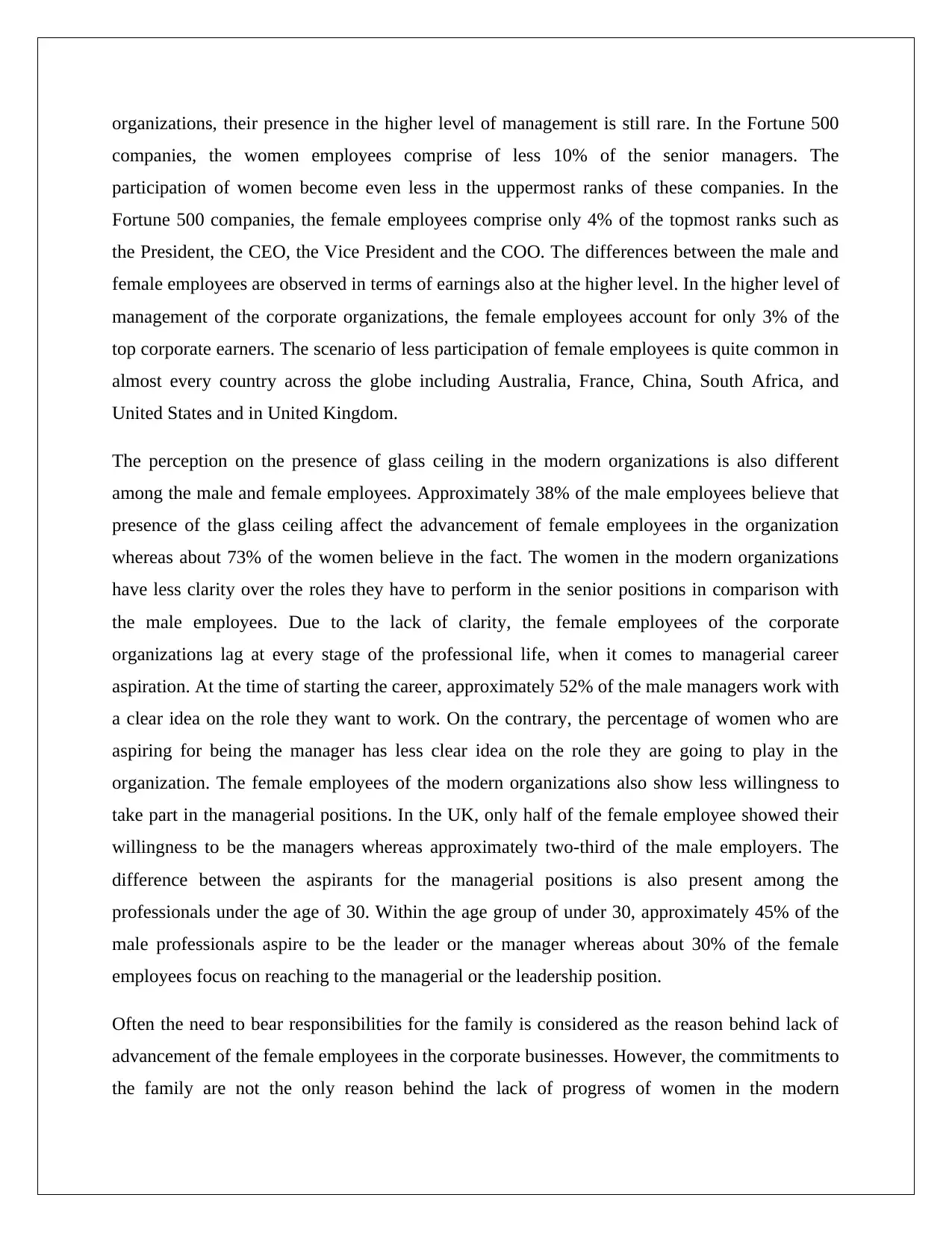
organizations, their presence in the higher level of management is still rare. In the Fortune 500
companies, the women employees comprise of less 10% of the senior managers. The
participation of women become even less in the uppermost ranks of these companies. In the
Fortune 500 companies, the female employees comprise only 4% of the topmost ranks such as
the President, the CEO, the Vice President and the COO. The differences between the male and
female employees are observed in terms of earnings also at the higher level. In the higher level of
management of the corporate organizations, the female employees account for only 3% of the
top corporate earners. The scenario of less participation of female employees is quite common in
almost every country across the globe including Australia, France, China, South Africa, and
United States and in United Kingdom.
The perception on the presence of glass ceiling in the modern organizations is also different
among the male and female employees. Approximately 38% of the male employees believe that
presence of the glass ceiling affect the advancement of female employees in the organization
whereas about 73% of the women believe in the fact. The women in the modern organizations
have less clarity over the roles they have to perform in the senior positions in comparison with
the male employees. Due to the lack of clarity, the female employees of the corporate
organizations lag at every stage of the professional life, when it comes to managerial career
aspiration. At the time of starting the career, approximately 52% of the male managers work with
a clear idea on the role they want to work. On the contrary, the percentage of women who are
aspiring for being the manager has less clear idea on the role they are going to play in the
organization. The female employees of the modern organizations also show less willingness to
take part in the managerial positions. In the UK, only half of the female employee showed their
willingness to be the managers whereas approximately two-third of the male employers. The
difference between the aspirants for the managerial positions is also present among the
professionals under the age of 30. Within the age group of under 30, approximately 45% of the
male professionals aspire to be the leader or the manager whereas about 30% of the female
employees focus on reaching to the managerial or the leadership position.
Often the need to bear responsibilities for the family is considered as the reason behind lack of
advancement of the female employees in the corporate businesses. However, the commitments to
the family are not the only reason behind the lack of progress of women in the modern
companies, the women employees comprise of less 10% of the senior managers. The
participation of women become even less in the uppermost ranks of these companies. In the
Fortune 500 companies, the female employees comprise only 4% of the topmost ranks such as
the President, the CEO, the Vice President and the COO. The differences between the male and
female employees are observed in terms of earnings also at the higher level. In the higher level of
management of the corporate organizations, the female employees account for only 3% of the
top corporate earners. The scenario of less participation of female employees is quite common in
almost every country across the globe including Australia, France, China, South Africa, and
United States and in United Kingdom.
The perception on the presence of glass ceiling in the modern organizations is also different
among the male and female employees. Approximately 38% of the male employees believe that
presence of the glass ceiling affect the advancement of female employees in the organization
whereas about 73% of the women believe in the fact. The women in the modern organizations
have less clarity over the roles they have to perform in the senior positions in comparison with
the male employees. Due to the lack of clarity, the female employees of the corporate
organizations lag at every stage of the professional life, when it comes to managerial career
aspiration. At the time of starting the career, approximately 52% of the male managers work with
a clear idea on the role they want to work. On the contrary, the percentage of women who are
aspiring for being the manager has less clear idea on the role they are going to play in the
organization. The female employees of the modern organizations also show less willingness to
take part in the managerial positions. In the UK, only half of the female employee showed their
willingness to be the managers whereas approximately two-third of the male employers. The
difference between the aspirants for the managerial positions is also present among the
professionals under the age of 30. Within the age group of under 30, approximately 45% of the
male professionals aspire to be the leader or the manager whereas about 30% of the female
employees focus on reaching to the managerial or the leadership position.
Often the need to bear responsibilities for the family is considered as the reason behind lack of
advancement of the female employees in the corporate businesses. However, the commitments to
the family are not the only reason behind the lack of progress of women in the modern
Paraphrase This Document
Need a fresh take? Get an instant paraphrase of this document with our AI Paraphraser
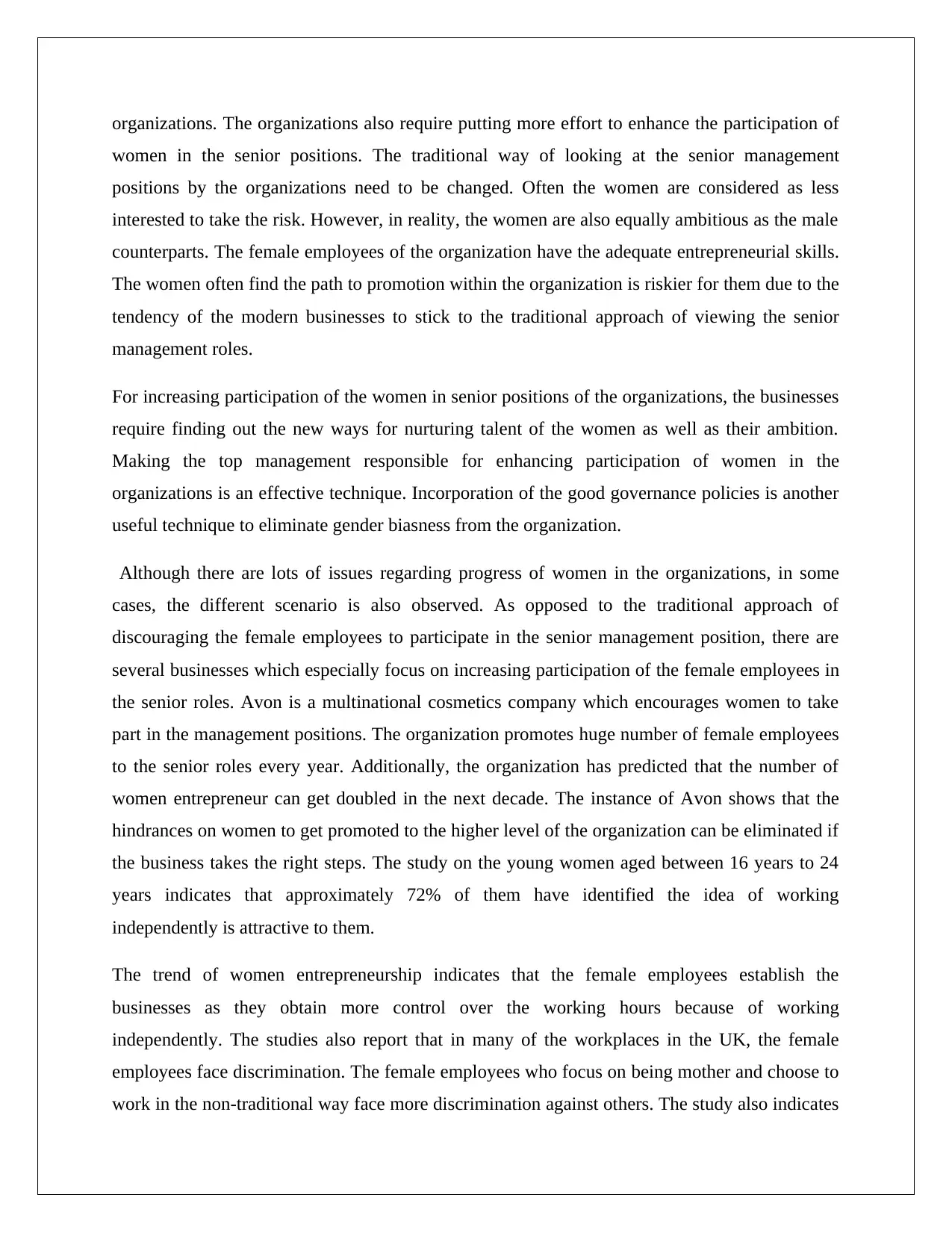
organizations. The organizations also require putting more effort to enhance the participation of
women in the senior positions. The traditional way of looking at the senior management
positions by the organizations need to be changed. Often the women are considered as less
interested to take the risk. However, in reality, the women are also equally ambitious as the male
counterparts. The female employees of the organization have the adequate entrepreneurial skills.
The women often find the path to promotion within the organization is riskier for them due to the
tendency of the modern businesses to stick to the traditional approach of viewing the senior
management roles.
For increasing participation of the women in senior positions of the organizations, the businesses
require finding out the new ways for nurturing talent of the women as well as their ambition.
Making the top management responsible for enhancing participation of women in the
organizations is an effective technique. Incorporation of the good governance policies is another
useful technique to eliminate gender biasness from the organization.
Although there are lots of issues regarding progress of women in the organizations, in some
cases, the different scenario is also observed. As opposed to the traditional approach of
discouraging the female employees to participate in the senior management position, there are
several businesses which especially focus on increasing participation of the female employees in
the senior roles. Avon is a multinational cosmetics company which encourages women to take
part in the management positions. The organization promotes huge number of female employees
to the senior roles every year. Additionally, the organization has predicted that the number of
women entrepreneur can get doubled in the next decade. The instance of Avon shows that the
hindrances on women to get promoted to the higher level of the organization can be eliminated if
the business takes the right steps. The study on the young women aged between 16 years to 24
years indicates that approximately 72% of them have identified the idea of working
independently is attractive to them.
The trend of women entrepreneurship indicates that the female employees establish the
businesses as they obtain more control over the working hours because of working
independently. The studies also report that in many of the workplaces in the UK, the female
employees face discrimination. The female employees who focus on being mother and choose to
work in the non-traditional way face more discrimination against others. The study also indicates
women in the senior positions. The traditional way of looking at the senior management
positions by the organizations need to be changed. Often the women are considered as less
interested to take the risk. However, in reality, the women are also equally ambitious as the male
counterparts. The female employees of the organization have the adequate entrepreneurial skills.
The women often find the path to promotion within the organization is riskier for them due to the
tendency of the modern businesses to stick to the traditional approach of viewing the senior
management roles.
For increasing participation of the women in senior positions of the organizations, the businesses
require finding out the new ways for nurturing talent of the women as well as their ambition.
Making the top management responsible for enhancing participation of women in the
organizations is an effective technique. Incorporation of the good governance policies is another
useful technique to eliminate gender biasness from the organization.
Although there are lots of issues regarding progress of women in the organizations, in some
cases, the different scenario is also observed. As opposed to the traditional approach of
discouraging the female employees to participate in the senior management position, there are
several businesses which especially focus on increasing participation of the female employees in
the senior roles. Avon is a multinational cosmetics company which encourages women to take
part in the management positions. The organization promotes huge number of female employees
to the senior roles every year. Additionally, the organization has predicted that the number of
women entrepreneur can get doubled in the next decade. The instance of Avon shows that the
hindrances on women to get promoted to the higher level of the organization can be eliminated if
the business takes the right steps. The study on the young women aged between 16 years to 24
years indicates that approximately 72% of them have identified the idea of working
independently is attractive to them.
The trend of women entrepreneurship indicates that the female employees establish the
businesses as they obtain more control over the working hours because of working
independently. The studies also report that in many of the workplaces in the UK, the female
employees face discrimination. The female employees who focus on being mother and choose to
work in the non-traditional way face more discrimination against others. The study also indicates
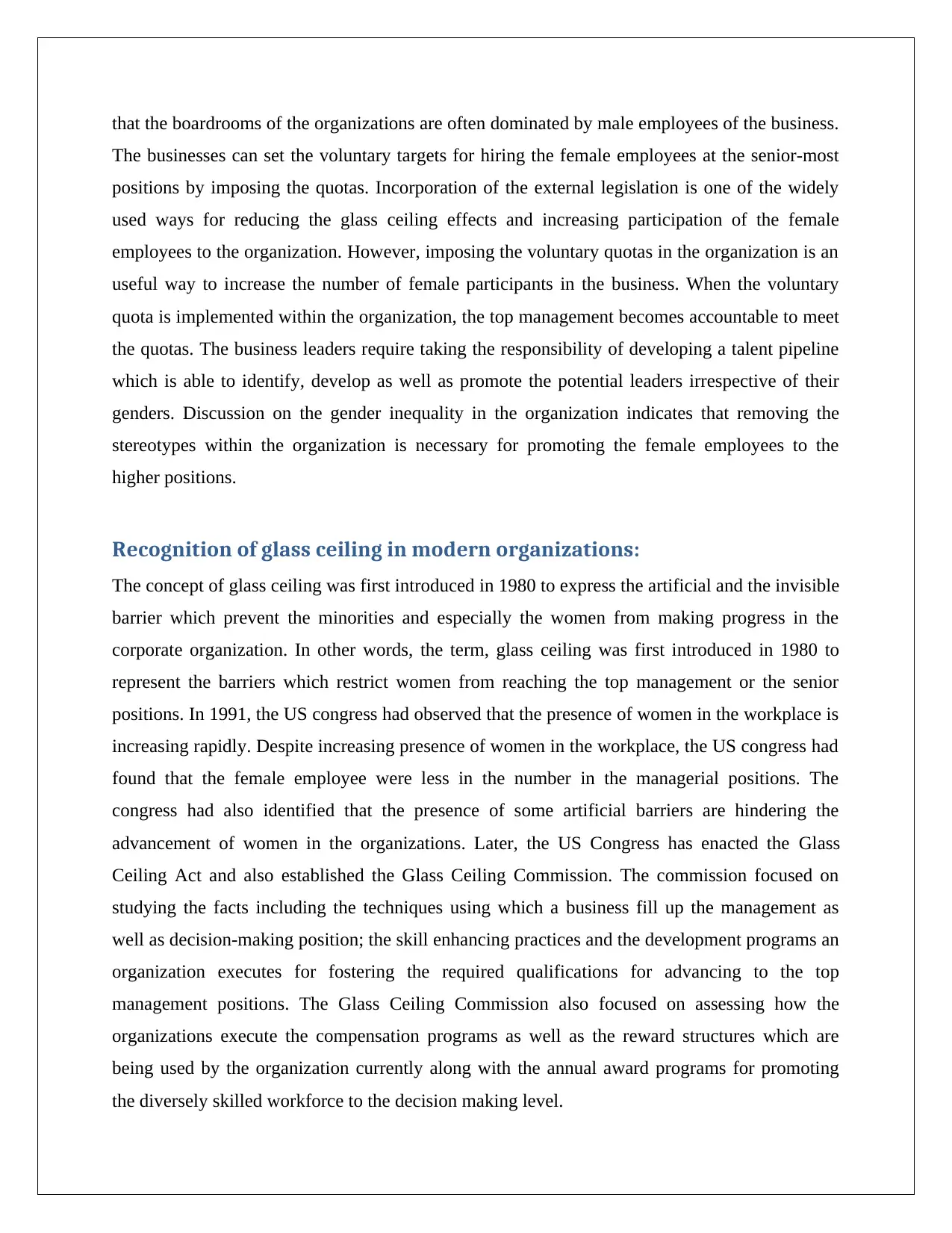
that the boardrooms of the organizations are often dominated by male employees of the business.
The businesses can set the voluntary targets for hiring the female employees at the senior-most
positions by imposing the quotas. Incorporation of the external legislation is one of the widely
used ways for reducing the glass ceiling effects and increasing participation of the female
employees to the organization. However, imposing the voluntary quotas in the organization is an
useful way to increase the number of female participants in the business. When the voluntary
quota is implemented within the organization, the top management becomes accountable to meet
the quotas. The business leaders require taking the responsibility of developing a talent pipeline
which is able to identify, develop as well as promote the potential leaders irrespective of their
genders. Discussion on the gender inequality in the organization indicates that removing the
stereotypes within the organization is necessary for promoting the female employees to the
higher positions.
Recognition of glass ceiling in modern organizations:
The concept of glass ceiling was first introduced in 1980 to express the artificial and the invisible
barrier which prevent the minorities and especially the women from making progress in the
corporate organization. In other words, the term, glass ceiling was first introduced in 1980 to
represent the barriers which restrict women from reaching the top management or the senior
positions. In 1991, the US congress had observed that the presence of women in the workplace is
increasing rapidly. Despite increasing presence of women in the workplace, the US congress had
found that the female employee were less in the number in the managerial positions. The
congress had also identified that the presence of some artificial barriers are hindering the
advancement of women in the organizations. Later, the US Congress has enacted the Glass
Ceiling Act and also established the Glass Ceiling Commission. The commission focused on
studying the facts including the techniques using which a business fill up the management as
well as decision-making position; the skill enhancing practices and the development programs an
organization executes for fostering the required qualifications for advancing to the top
management positions. The Glass Ceiling Commission also focused on assessing how the
organizations execute the compensation programs as well as the reward structures which are
being used by the organization currently along with the annual award programs for promoting
the diversely skilled workforce to the decision making level.
The businesses can set the voluntary targets for hiring the female employees at the senior-most
positions by imposing the quotas. Incorporation of the external legislation is one of the widely
used ways for reducing the glass ceiling effects and increasing participation of the female
employees to the organization. However, imposing the voluntary quotas in the organization is an
useful way to increase the number of female participants in the business. When the voluntary
quota is implemented within the organization, the top management becomes accountable to meet
the quotas. The business leaders require taking the responsibility of developing a talent pipeline
which is able to identify, develop as well as promote the potential leaders irrespective of their
genders. Discussion on the gender inequality in the organization indicates that removing the
stereotypes within the organization is necessary for promoting the female employees to the
higher positions.
Recognition of glass ceiling in modern organizations:
The concept of glass ceiling was first introduced in 1980 to express the artificial and the invisible
barrier which prevent the minorities and especially the women from making progress in the
corporate organization. In other words, the term, glass ceiling was first introduced in 1980 to
represent the barriers which restrict women from reaching the top management or the senior
positions. In 1991, the US congress had observed that the presence of women in the workplace is
increasing rapidly. Despite increasing presence of women in the workplace, the US congress had
found that the female employee were less in the number in the managerial positions. The
congress had also identified that the presence of some artificial barriers are hindering the
advancement of women in the organizations. Later, the US Congress has enacted the Glass
Ceiling Act and also established the Glass Ceiling Commission. The commission focused on
studying the facts including the techniques using which a business fill up the management as
well as decision-making position; the skill enhancing practices and the development programs an
organization executes for fostering the required qualifications for advancing to the top
management positions. The Glass Ceiling Commission also focused on assessing how the
organizations execute the compensation programs as well as the reward structures which are
being used by the organization currently along with the annual award programs for promoting
the diversely skilled workforce to the decision making level.
⊘ This is a preview!⊘
Do you want full access?
Subscribe today to unlock all pages.

Trusted by 1+ million students worldwide
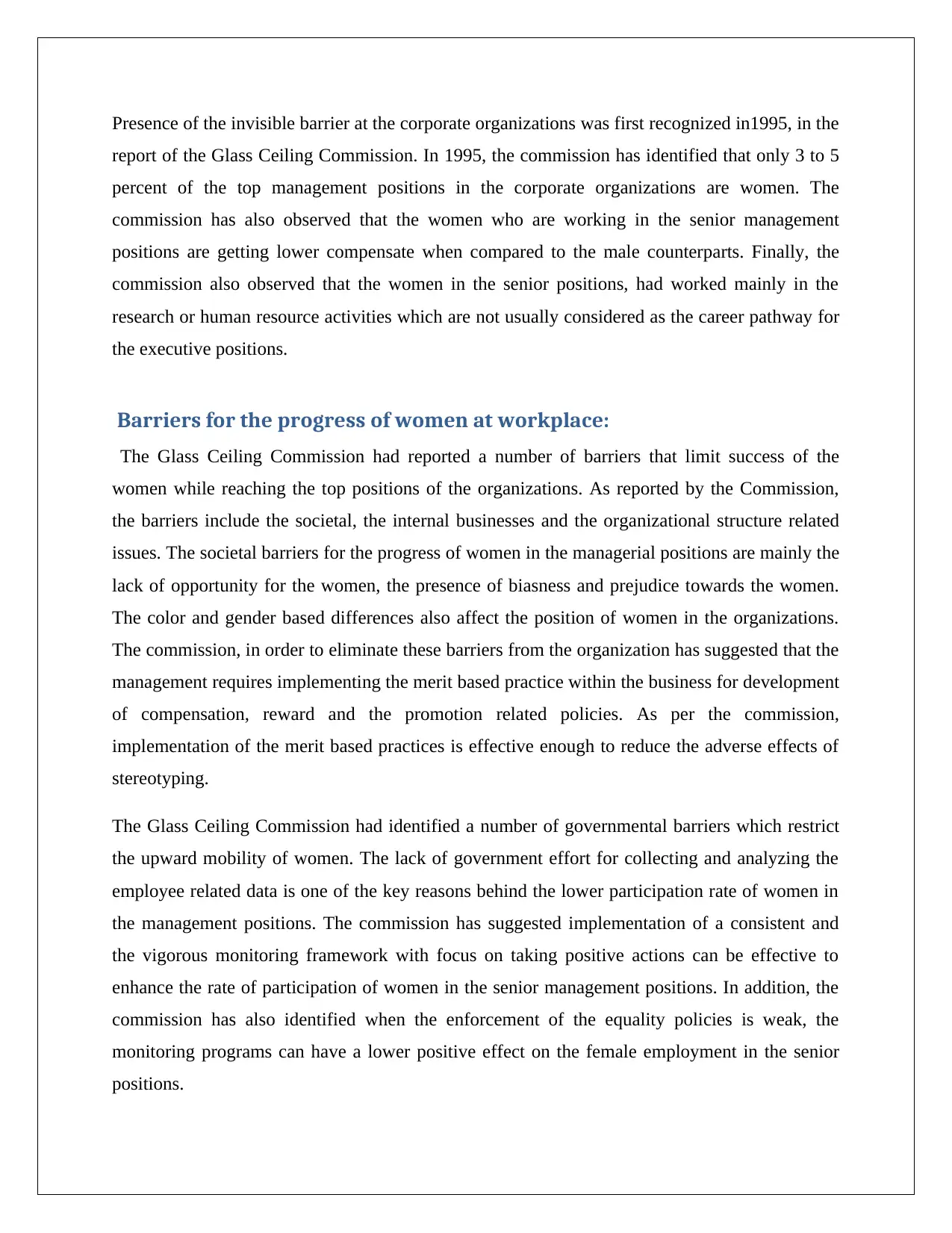
Presence of the invisible barrier at the corporate organizations was first recognized in1995, in the
report of the Glass Ceiling Commission. In 1995, the commission has identified that only 3 to 5
percent of the top management positions in the corporate organizations are women. The
commission has also observed that the women who are working in the senior management
positions are getting lower compensate when compared to the male counterparts. Finally, the
commission also observed that the women in the senior positions, had worked mainly in the
research or human resource activities which are not usually considered as the career pathway for
the executive positions.
Barriers for the progress of women at workplace:
The Glass Ceiling Commission had reported a number of barriers that limit success of the
women while reaching the top positions of the organizations. As reported by the Commission,
the barriers include the societal, the internal businesses and the organizational structure related
issues. The societal barriers for the progress of women in the managerial positions are mainly the
lack of opportunity for the women, the presence of biasness and prejudice towards the women.
The color and gender based differences also affect the position of women in the organizations.
The commission, in order to eliminate these barriers from the organization has suggested that the
management requires implementing the merit based practice within the business for development
of compensation, reward and the promotion related policies. As per the commission,
implementation of the merit based practices is effective enough to reduce the adverse effects of
stereotyping.
The Glass Ceiling Commission had identified a number of governmental barriers which restrict
the upward mobility of women. The lack of government effort for collecting and analyzing the
employee related data is one of the key reasons behind the lower participation rate of women in
the management positions. The commission has suggested implementation of a consistent and
the vigorous monitoring framework with focus on taking positive actions can be effective to
enhance the rate of participation of women in the senior management positions. In addition, the
commission has also identified when the enforcement of the equality policies is weak, the
monitoring programs can have a lower positive effect on the female employment in the senior
positions.
report of the Glass Ceiling Commission. In 1995, the commission has identified that only 3 to 5
percent of the top management positions in the corporate organizations are women. The
commission has also observed that the women who are working in the senior management
positions are getting lower compensate when compared to the male counterparts. Finally, the
commission also observed that the women in the senior positions, had worked mainly in the
research or human resource activities which are not usually considered as the career pathway for
the executive positions.
Barriers for the progress of women at workplace:
The Glass Ceiling Commission had reported a number of barriers that limit success of the
women while reaching the top positions of the organizations. As reported by the Commission,
the barriers include the societal, the internal businesses and the organizational structure related
issues. The societal barriers for the progress of women in the managerial positions are mainly the
lack of opportunity for the women, the presence of biasness and prejudice towards the women.
The color and gender based differences also affect the position of women in the organizations.
The commission, in order to eliminate these barriers from the organization has suggested that the
management requires implementing the merit based practice within the business for development
of compensation, reward and the promotion related policies. As per the commission,
implementation of the merit based practices is effective enough to reduce the adverse effects of
stereotyping.
The Glass Ceiling Commission had identified a number of governmental barriers which restrict
the upward mobility of women. The lack of government effort for collecting and analyzing the
employee related data is one of the key reasons behind the lower participation rate of women in
the management positions. The commission has suggested implementation of a consistent and
the vigorous monitoring framework with focus on taking positive actions can be effective to
enhance the rate of participation of women in the senior management positions. In addition, the
commission has also identified when the enforcement of the equality policies is weak, the
monitoring programs can have a lower positive effect on the female employment in the senior
positions.
Paraphrase This Document
Need a fresh take? Get an instant paraphrase of this document with our AI Paraphraser
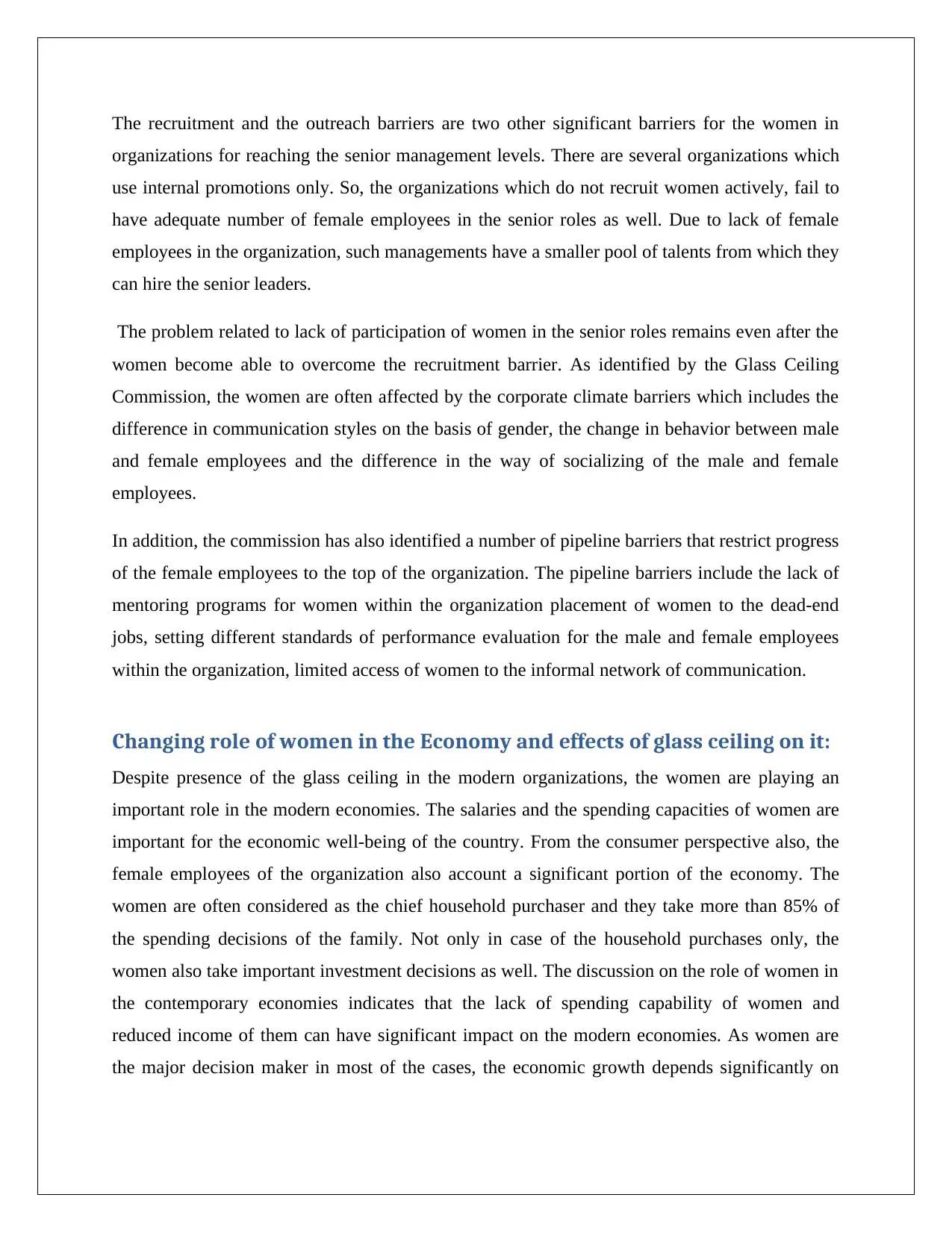
The recruitment and the outreach barriers are two other significant barriers for the women in
organizations for reaching the senior management levels. There are several organizations which
use internal promotions only. So, the organizations which do not recruit women actively, fail to
have adequate number of female employees in the senior roles as well. Due to lack of female
employees in the organization, such managements have a smaller pool of talents from which they
can hire the senior leaders.
The problem related to lack of participation of women in the senior roles remains even after the
women become able to overcome the recruitment barrier. As identified by the Glass Ceiling
Commission, the women are often affected by the corporate climate barriers which includes the
difference in communication styles on the basis of gender, the change in behavior between male
and female employees and the difference in the way of socializing of the male and female
employees.
In addition, the commission has also identified a number of pipeline barriers that restrict progress
of the female employees to the top of the organization. The pipeline barriers include the lack of
mentoring programs for women within the organization placement of women to the dead-end
jobs, setting different standards of performance evaluation for the male and female employees
within the organization, limited access of women to the informal network of communication.
Changing role of women in the Economy and effects of glass ceiling on it:
Despite presence of the glass ceiling in the modern organizations, the women are playing an
important role in the modern economies. The salaries and the spending capacities of women are
important for the economic well-being of the country. From the consumer perspective also, the
female employees of the organization also account a significant portion of the economy. The
women are often considered as the chief household purchaser and they take more than 85% of
the spending decisions of the family. Not only in case of the household purchases only, the
women also take important investment decisions as well. The discussion on the role of women in
the contemporary economies indicates that the lack of spending capability of women and
reduced income of them can have significant impact on the modern economies. As women are
the major decision maker in most of the cases, the economic growth depends significantly on
organizations for reaching the senior management levels. There are several organizations which
use internal promotions only. So, the organizations which do not recruit women actively, fail to
have adequate number of female employees in the senior roles as well. Due to lack of female
employees in the organization, such managements have a smaller pool of talents from which they
can hire the senior leaders.
The problem related to lack of participation of women in the senior roles remains even after the
women become able to overcome the recruitment barrier. As identified by the Glass Ceiling
Commission, the women are often affected by the corporate climate barriers which includes the
difference in communication styles on the basis of gender, the change in behavior between male
and female employees and the difference in the way of socializing of the male and female
employees.
In addition, the commission has also identified a number of pipeline barriers that restrict progress
of the female employees to the top of the organization. The pipeline barriers include the lack of
mentoring programs for women within the organization placement of women to the dead-end
jobs, setting different standards of performance evaluation for the male and female employees
within the organization, limited access of women to the informal network of communication.
Changing role of women in the Economy and effects of glass ceiling on it:
Despite presence of the glass ceiling in the modern organizations, the women are playing an
important role in the modern economies. The salaries and the spending capacities of women are
important for the economic well-being of the country. From the consumer perspective also, the
female employees of the organization also account a significant portion of the economy. The
women are often considered as the chief household purchaser and they take more than 85% of
the spending decisions of the family. Not only in case of the household purchases only, the
women also take important investment decisions as well. The discussion on the role of women in
the contemporary economies indicates that the lack of spending capability of women and
reduced income of them can have significant impact on the modern economies. As women are
the major decision maker in most of the cases, the economic growth depends significantly on
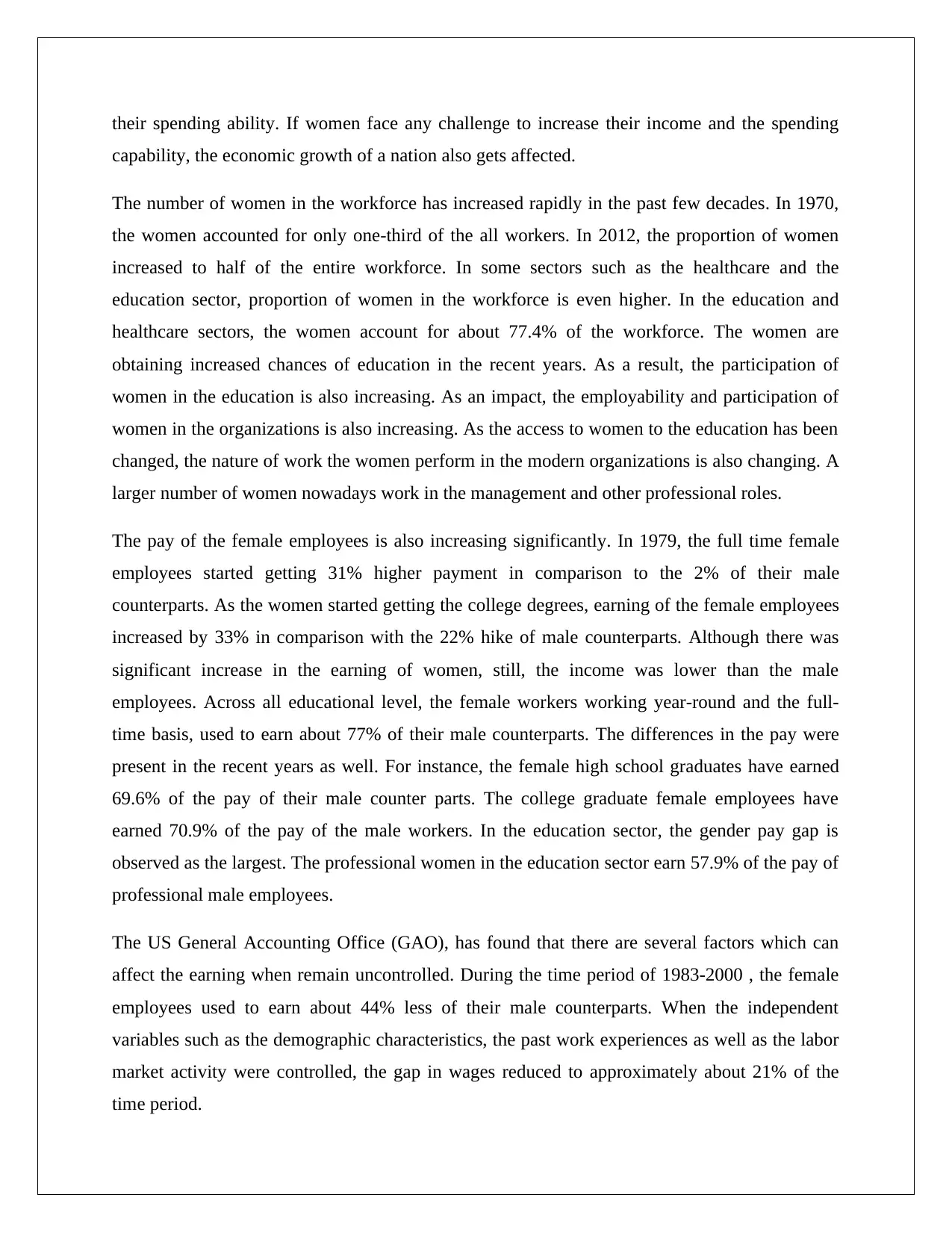
their spending ability. If women face any challenge to increase their income and the spending
capability, the economic growth of a nation also gets affected.
The number of women in the workforce has increased rapidly in the past few decades. In 1970,
the women accounted for only one-third of the all workers. In 2012, the proportion of women
increased to half of the entire workforce. In some sectors such as the healthcare and the
education sector, proportion of women in the workforce is even higher. In the education and
healthcare sectors, the women account for about 77.4% of the workforce. The women are
obtaining increased chances of education in the recent years. As a result, the participation of
women in the education is also increasing. As an impact, the employability and participation of
women in the organizations is also increasing. As the access to women to the education has been
changed, the nature of work the women perform in the modern organizations is also changing. A
larger number of women nowadays work in the management and other professional roles.
The pay of the female employees is also increasing significantly. In 1979, the full time female
employees started getting 31% higher payment in comparison to the 2% of their male
counterparts. As the women started getting the college degrees, earning of the female employees
increased by 33% in comparison with the 22% hike of male counterparts. Although there was
significant increase in the earning of women, still, the income was lower than the male
employees. Across all educational level, the female workers working year-round and the full-
time basis, used to earn about 77% of their male counterparts. The differences in the pay were
present in the recent years as well. For instance, the female high school graduates have earned
69.6% of the pay of their male counter parts. The college graduate female employees have
earned 70.9% of the pay of the male workers. In the education sector, the gender pay gap is
observed as the largest. The professional women in the education sector earn 57.9% of the pay of
professional male employees.
The US General Accounting Office (GAO), has found that there are several factors which can
affect the earning when remain uncontrolled. During the time period of 1983-2000 , the female
employees used to earn about 44% less of their male counterparts. When the independent
variables such as the demographic characteristics, the past work experiences as well as the labor
market activity were controlled, the gap in wages reduced to approximately about 21% of the
time period.
capability, the economic growth of a nation also gets affected.
The number of women in the workforce has increased rapidly in the past few decades. In 1970,
the women accounted for only one-third of the all workers. In 2012, the proportion of women
increased to half of the entire workforce. In some sectors such as the healthcare and the
education sector, proportion of women in the workforce is even higher. In the education and
healthcare sectors, the women account for about 77.4% of the workforce. The women are
obtaining increased chances of education in the recent years. As a result, the participation of
women in the education is also increasing. As an impact, the employability and participation of
women in the organizations is also increasing. As the access to women to the education has been
changed, the nature of work the women perform in the modern organizations is also changing. A
larger number of women nowadays work in the management and other professional roles.
The pay of the female employees is also increasing significantly. In 1979, the full time female
employees started getting 31% higher payment in comparison to the 2% of their male
counterparts. As the women started getting the college degrees, earning of the female employees
increased by 33% in comparison with the 22% hike of male counterparts. Although there was
significant increase in the earning of women, still, the income was lower than the male
employees. Across all educational level, the female workers working year-round and the full-
time basis, used to earn about 77% of their male counterparts. The differences in the pay were
present in the recent years as well. For instance, the female high school graduates have earned
69.6% of the pay of their male counter parts. The college graduate female employees have
earned 70.9% of the pay of the male workers. In the education sector, the gender pay gap is
observed as the largest. The professional women in the education sector earn 57.9% of the pay of
professional male employees.
The US General Accounting Office (GAO), has found that there are several factors which can
affect the earning when remain uncontrolled. During the time period of 1983-2000 , the female
employees used to earn about 44% less of their male counterparts. When the independent
variables such as the demographic characteristics, the past work experiences as well as the labor
market activity were controlled, the gap in wages reduced to approximately about 21% of the
time period.
⊘ This is a preview!⊘
Do you want full access?
Subscribe today to unlock all pages.

Trusted by 1+ million students worldwide
1 out of 13
Related Documents
Your All-in-One AI-Powered Toolkit for Academic Success.
+13062052269
info@desklib.com
Available 24*7 on WhatsApp / Email
![[object Object]](/_next/static/media/star-bottom.7253800d.svg)
Unlock your academic potential
Copyright © 2020–2025 A2Z Services. All Rights Reserved. Developed and managed by ZUCOL.





